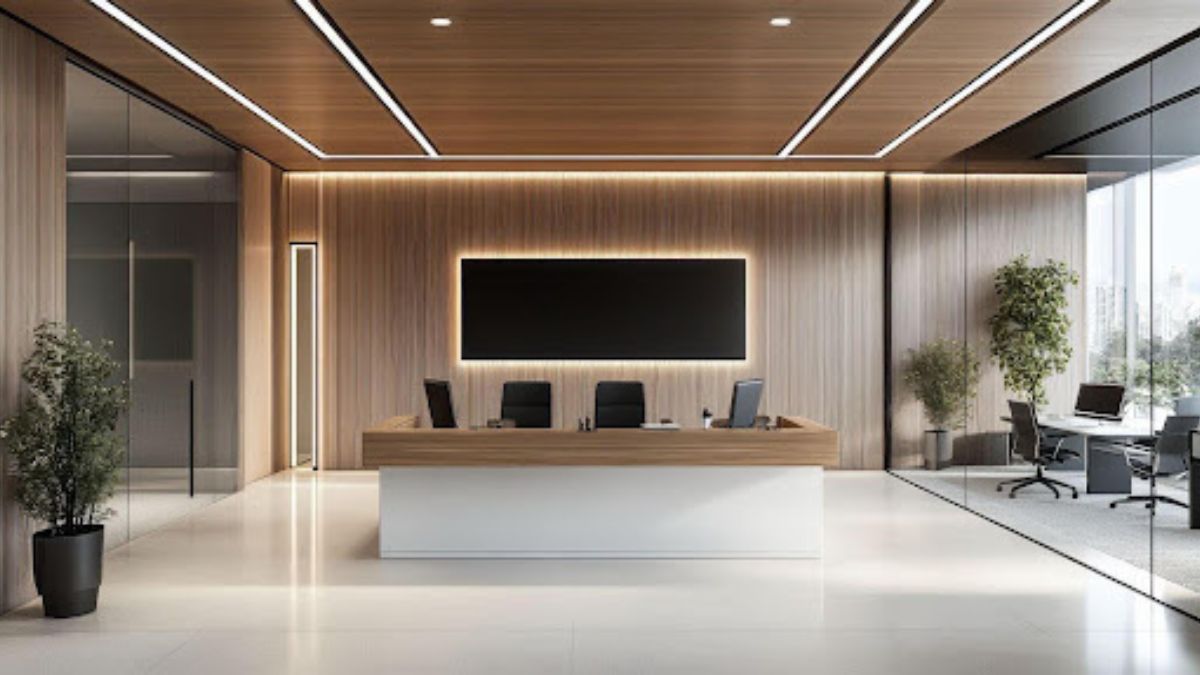TOPIC
What Defines A Modern Reception Desk?

A modern reception desk not only welcomes visitors but also sets the tone of your company from day one. In corporate and industrial spaces or any company, the reception reflects the company. Selecting the correct desk is no longer just about functionality but an issue of design sense, technological integration, ergonomics, and operational efficiency.
These days, companies are leaning towards reception areas that not only enhance employee well-being but also provide clients with a seamless experience. As offices embrace open layouts and smart environments, reception desks are becoming key focal points, balancing style with practicality.
Thus, businesses must tackle most of the design and structural aspects to provide the reception desk area as it is today. From sleek, modern styles to incorporated technology, today’s reception desk is designed to deliver and impress.
This article discusses the most significant features that characterize the reception desk in today’s industry environment.
1. Should Feature a Sleek, Minimalist Design
Regarding reception desks, a minimalist and modern design sets the tone for a contemporary space. Unlike those bulky, old-fashioned options, these desks boast sleek lines, flat surfaces, and a subtle profile. For instance, businesses that choose a modern reception desk often go for designs that blend with vibrant and understated decor styles effortlessly.
Always consider a modern reception desk that focuses on functionality and stylish design. They may come in modular forms, allowing companies to tailor dimensions and layouts to fit their specific space needs. Plus, the minimalist aesthetic helps draw attention while minimizing visual clutter in busy reception areas, leaving a long-lasting impression on visitors and employees.
Moreover, many of these desks are crafted to fit seamlessly into industrial decor themes, featuring elements like shiny polished concrete floors, exposed ceilings, and a monochromatic color palette. This makes them a perfect fit for modern offices, enhancing the overall look without overshadowing other design elements.
2. Must be of High-Quality Materials
Besides the minimalist design, material quality is essential in determining how modern or up-to-date a reception desk appears and functions. Unlike when reception desks were made from laminate and particleboard, today’s reception desks feature high-quality materials like tempered glass, brushed aluminum, stone finishes, and engineered wood.
Furthermore, such materials’ tactile quality and durability ensure long application and enhance the office atmosphere. For example, metal-framed desks and glass surfaces look chic, especially in busy reception areas where they can handle a lot of wear and tear.
In addition, using materials like FSC-certified wood and low-VOC finishes also brings today’s reception areas, reception desks included, into harmony with environmentally responsible business practices. In this way, companies not only address appearance but corporate social responsibility as well.
3. Integrated Technology for Functionality
Transitions from material to functionality and integrated technology are other features of a modern reception desk. With intelligent offices becoming increasingly prevalent, reception areas today include integrated technological components that augment guest and employee experiences.
For instance, reception spaces can have hidden cable management systems, wireless charging stations, touchscreen kiosks, and LED strip lighting. All these elements keep the space functional while keeping it clear of obstructions. Moreover, reception counters that support digital signage or tablet mounts allow for straightforward orientation of visitors and reduce paperwork to an absolute minimum.
Hence, tech-enabled workstations create a sleek, cutting-edge first impression, ensuring your office lives up to the expectations of efficiency and innovation. Incorporated tech works enhance usability and project an image of forward-thinking companies.

4. Prioritize Ergonomic Setup
An ergonomic reception desk design is almost as important as form and functionality, as receptionists dedicate several hours to welcoming visitors, answering calls, and managing schedules. The desk, therefore, needs to be comfortable as well as efficient.
For this reason, modern reception counters include sit-stand capability and adjustable heights, allowing for the ergonomic placement of monitors and keyboards. Footrests and anti-fatigue matting are also included in the installation to alleviate fatigue over time.
Interestingly, most modern layouts include double-level surfaces, allowing clerical work to be performed while presenting a professional front to visitors. This two-in-one method increases efficiency and provides the added benefit of creating an established boundary between guest spaces of interaction and working spaces.
5. Must Have Ample Storage Solutions
Also, functional storage is an integral part of an optimally designed reception desk. Modern styles favor hidden or integrated storage spaces, allowing organized and neat working spaces. From lockable drawers and open shelves to filing cabinets and concealed printer pedestals, these desks strive to be as functional as possible without compromising appearance.
In contrast to older reception designs that were filled with office equipment and paperwork, today’s reception desks feature cable organizers and systems for organization designed into them. This keeps front-of-house areas tidy and unobstructed, which harmonizes well with a welcoming ambiance.
Furthermore, the customized storage compartments in these desks address diverse corporate needs, be it storing marketing brochures, visitor books, or computer peripherals. Overall, the storage compartments add to the operational efficiency at workspaces without taking away from the minimalist appearance.
6. Should Contain Privacy features
Finally, today’s reception areas also include elements that provide privacy for visitors and staff. Modesty screens or privacy panels in heavy-usage regions are needed to protect sensitive data and provide an environment for more focused work.
In addition, strategic workspace design incorporates sloped surfaces, frosted glass paneling, or side panels to obstruct the direct sight of screens and papers. This is most important in industries that handle sensitive materials, such as healthcare law, and financial institutions.
With privacy-conscious design elements, reception desks today create an ambiance of professionalism and confidence. They also ensure workers have an interruption-free environment in which to perform critical front office functions.

Conclusion
In short, today’s reception desk is not just an item of furniture. It’s an instrument for creating the image and workflow of a company. With their sleek design, superior materials, incorporated technology, ergonomic design, smart storage, and sensitivity to privacy, reception desks like these embody the sophistication and efficiency one can expect to find in today’s industrial and professional environments.
Since businesses continue to remodel offices, the reception is still at the forefront of establishing that critical first impression. An up-to-date reception desk that combines form and functionality is an astute and pragmatic move.
TOPIC
Greener Grass Landscaping: The Art of Sustainable Outdoor Beauty

Introduction to Greener Grass Landscaping
Greener Grass Landscaping has become a defining concept for property owners who want outdoor spaces that look beautiful while remaining environmentally responsible. In modern communities, landscaping is no longer just about trimming lawns or planting flowers; it is about creating balanced ecosystems that improve air quality, conserve water, and enhance property value. The growing awareness of sustainability has pushed homeowners and businesses alike to rethink how their outdoor areas are designed and maintained, making this approach more relevant than ever.
The Philosophy Behind Greener Grass Landscaping
The philosophy of Greener Grass Landscaping centers on harmony between nature and design. Instead of forcing landscapes to conform to artificial standards, this approach works with local soil, climate, and plant life. By focusing on natural growth patterns and eco-friendly practices, landscapes remain healthier and more resilient. This philosophy encourages long-term planning, reduced chemical use, and smarter resource management, all of which contribute to outdoor spaces that thrive naturally.
How Greener Grass Landscaping Enhances Property Appeal
Greener Grass Landscaping plays a vital role in enhancing the visual and functional appeal of any property. A well-maintained green lawn creates a welcoming atmosphere, whether for a family home, office complex, or public park. Beyond aesthetics, thoughtful landscaping improves drainage, reduces soil erosion, and creates comfortable outdoor areas for relaxation. These benefits combine to increase overall property value and leave a lasting impression on visitors.
To understand the visual and practical impact, consider the comparison below presented within this discussion:
| Landscaping Aspect | Traditional Approach | Sustainable Approach |
| Lawn Appearance | Short-term green look | Long-lasting natural vibrancy |
| Maintenance Cost | High over time | Reduced with smart planning |
| Environmental Impact | Resource intensive | Eco-friendly and balanced |
This comparison highlights why modern property owners are shifting toward sustainable landscaping models.
Sustainable Lawn Care Practices in Greener Grass Landscaping
Sustainability is at the core of Greener Grass Landscaping, particularly when it comes to lawn care practices. Instead of relying heavily on synthetic fertilizers, organic soil enrichment methods are preferred to maintain nutrient balance. Water conservation is another critical element, achieved through efficient irrigation systems and drought-resistant grass varieties. These practices not only reduce environmental strain but also ensure that lawns remain healthy throughout seasonal changes.
A brief overview of common practices can be seen in the following table, integrated into this explanation:
| Practice Area | Sustainable Method | Long-Term Benefit |
| Soil Health | Natural compost use | Improved root strength |
| Water Usage | Smart irrigation | Lower utility costs |
| Lawn Growth | Native grass types | Better climate adaptation |
Each method contributes to a lawn that requires less intervention while maintaining its lush appearance.
Design Planning and Greener Grass Landscaping
Effective design planning is essential to the success of Greener Grass Landscaping. Landscape design goes beyond choosing plants; it involves understanding space, sunlight patterns, and user needs. Thoughtful planning ensures that outdoor areas are functional as well as visually pleasing. Pathways, green zones, and shaded areas are carefully arranged to create a seamless flow that complements the natural environment rather than disrupting it.
This planning process often includes evaluating soil conditions and selecting plant species that thrive naturally in the area. When design aligns with nature, maintenance becomes easier, and the landscape remains vibrant throughout the year.
Environmental Benefits of Greener Grass Landscaping
The environmental advantages of Greener Grass Landscaping extend far beyond individual properties. Green spaces help regulate temperature, reduce urban heat, and support local biodiversity. By minimizing chemical runoff and conserving water, these landscapes protect nearby ecosystems. Trees, shrubs, and healthy lawns also play a role in improving air quality by absorbing pollutants and producing oxygen, contributing positively to community well-being.
The table below illustrates how environmental benefits align with landscaping choices:
| Environmental Factor | Landscaping Choice | Positive Outcome |
| Air Quality | Dense green coverage | Cleaner surroundings |
| Water Conservation | Efficient irrigation | Reduced waste |
| Biodiversity | Native plants | Balanced ecosystems |
These outcomes demonstrate how thoughtful landscaping can make a meaningful environmental difference.
Seasonal Care in Greener Grass Landscaping
Seasonal care is an important aspect of Greener Grass Landscaping because landscapes change with weather patterns. Proper planning ensures that lawns and plants remain healthy during both warm and cooler months. Seasonal adjustments in watering, trimming, and soil treatment help maintain consistent growth without overuse of resources. This adaptive care approach allows landscapes to respond naturally to environmental changes, resulting in stronger and more resilient outdoor spaces.
Understanding seasonal cycles also helps prevent common lawn issues, ensuring that the landscape remains attractive throughout the year.
The Economic Value of Greener Grass Landscaping
Investing in Greener Grass Landscaping provides economic benefits alongside environmental ones. While initial planning may require thoughtful budgeting, the long-term savings are significant. Reduced water usage, lower maintenance needs, and healthier plant life contribute to decreased operational costs. Additionally, properties with attractive and sustainable landscapes often experience increased market value, making this approach financially rewarding.
The following comparison illustrates cost efficiency over time:
| Cost Aspect | Short-Term Focus | Long-Term Sustainable Focus |
| Maintenance Expenses | Increasing annually | Stable or reduced |
| Water Bills | High consumption | Optimized usage |
| Property Value | Moderate growth | Strong appreciation |
This demonstrates how sustainable landscaping supports financial stability.
Choosing the Right Approach for Greener Grass Landscaping
Selecting the right approach for Greener Grass Landscaping requires understanding both personal goals and environmental conditions. Every property is unique, and landscaping strategies should reflect that individuality. Factors such as climate, soil type, and usage patterns influence design and maintenance decisions. By aligning these elements, property owners can create outdoor spaces that are not only attractive but also practical and sustainable.
Professional guidance often helps in identifying the most effective solutions, ensuring that landscapes remain healthy and visually appealing over time.
The Future Outlook of Greener Grass Landscaping
The future of Greener Grass Landscaping looks promising as sustainability continues to shape lifestyle choices. Innovations in irrigation technology, soil management, and plant selection are making eco-friendly landscaping more accessible. As communities place greater emphasis on green living, landscaped spaces will play an even more significant role in urban and residential planning.
This forward-looking approach ensures that outdoor environments contribute positively to both human comfort and ecological balance, reinforcing the importance of sustainable landscaping practices.
Conclusion
Greener Grass Landscaping represents more than a trend; it reflects a thoughtful commitment to sustainability, beauty, and long-term value. By focusing on natural harmony, efficient resource use, and intelligent design, this approach transforms outdoor spaces into thriving ecosystems. Whether enhancing a home garden or a commercial property, sustainable landscaping delivers aesthetic appeal, environmental benefits, and economic advantages that stand the test of time.
TOPIC
The Rise of Scamiikely: How It’s Changing Online Interactions

Introduction to Scamiikely
The digital world has transformed how we connect, communicate, and interact. However, with every innovation comes new challenges. Enter Scamiikely—an unsettling trend that’s making waves across online platforms. As technology evolves, so do the tactics of those who aim to exploit it for nefarious purposes. The rise of Scamiikely is changing the landscape of online interactions like never before.
People are increasingly falling victim to deceitful schemes masquerading as genuine connections or opportunities. Understanding this phenomenon is crucial in today’s hyper-connected society. In this article, we’ll explore what Scamiikely entails and uncover its implications on our digital lives. Buckle up as we delve into a topic that affects us all!
What is Scamiikely and How Does it Work?
Scamiikely is an emerging phenomenon in the digital landscape. It refers to a new wave of online scams that cleverly manipulate users into sharing personal information or money.
The mechanics behind Scamiikely are surprisingly simple yet effective. Scammers use social engineering techniques, crafting messages that appear legitimate and trustworthy. They often impersonate known brands, influencers, or even friends to gain victims’ trust.
Once this connection is established, they lure individuals with enticing offers—like unbelievable discounts or investment opportunities—that seem too good to pass up.
Victims then provide sensitive details or make payments without realizing they’re being exploited. The rapid evolution of technology has only made these tactics more sophisticated and harder to detect.
As awareness grows about Scamiikely, it becomes crucial for internet users to stay informed and vigilant against these deceptive practices.
The Impact of Scamiikely on Online Interactions
Scamiikely is reshaping the way people interact online. With a surge in deceptive practices, trust is now a rare commodity in digital spaces. Individuals are becoming increasingly wary, questioning intentions behind messages and posts.
As users navigate social platforms, they find themselves second-guessing interactions that once felt genuine. This skepticism can lead to isolation as connections weaken under the weight of uncertainty.
Moreover, communities are beginning to adopt more stringent verification methods. Conversations that were once open and spontaneous now require extra layers of caution.
The emotional toll is significant; anxiety about being scammed lurks behind every notification or friend request. As individuals prioritize security over spontaneity, the essence of authentic connection risks fading away amidst the rise of Scamiikely’s influence.
Types of Scams and How to Identify Them
Scamiikely has introduced various types of scams that prey on unsuspecting users. Recognizing these tactics is essential for staying safe online.
Phishing scams are among the most common. They often appear as fake emails or messages from reputable sources, enticing victims to click malicious links. Always check sender details and avoid sharing personal information.
Romance scams exploit emotional connections, usually starting on dating platforms. These scammers build trust before asking for money under false pretenses. Look out for quick declarations of love or requests for financial support.
Then there are lottery and prize scams, which promise rewards but require upfront fees or personal data to claim them. Legitimate lotteries never ask you to pay in advance.
Investment schemes lure individuals with promises of high returns with little risk involved. If it sounds too good to be true, it probably is—do your research first!
Protecting Yourself from Scamiikely
To protect yourself from Scamiikely, first, stay informed. Knowledge is a powerful tool against deception. Familiarize yourself with common scams and tactics used by scammers.
Be cautious when sharing personal information online. Always verify the identity of those you engage with, especially in unfamiliar situations or platforms.
Use strong passwords and enable two-factor authentication on your accounts. This adds an extra layer of security that can deter potential threats.
Trust your instincts; if something feels off, it probably is. Don’t hesitate to report suspicious activities to authorities or platform administrators.
Regularly review your financial statements for any unauthorized transactions. Early detection can save you from significant losses down the line.
Stay connected with friends and family about online interactions they encounter. Sharing experiences creates a support network that enhances awareness and protection against Scamiikely’s reach.
The Role of Social Media in the Rise of Scamiikely
Social media platforms have become breeding grounds for Scamiikely. With millions of users interacting daily, these networks facilitate quick and often unchecked communication.
Scammers exploit the vast reach of social media to target unsuspecting individuals. They create fake accounts that mimic legitimate profiles, luring victims with enticing offers or emotional stories.
The viral nature of content on these platforms amplifies their efforts. A single post can spread misinformation within minutes, making it difficult for users to discern fact from fiction.
Moreover, the anonymity offered by social media allows scammers to operate with minimal risk. This environment fosters a sense of trust among users, which is easily manipulated by those who seek to deceive.
As people share personal information freely online, they inadvertently give scammers tools for more sophisticated attacks. The combination of accessibility and vulnerability has made social media an ideal platform for Scamiikely’s growth.
The Future of Online Interactions with Scamiikely
The future of online interactions is poised for a significant shift with the prevalence of Scamiikely. As digital platforms evolve, user awareness and vigilance will become paramount. More individuals are likely to educate themselves about scams, leading to a more informed online community.
Technology may also play a pivotal role in this landscape. Advanced algorithms could help identify potential scam patterns before they reach unsuspecting users. This proactive approach might foster safer online environments.
Moreover, as social media continues its rapid growth, the way people connect will change dramatically. While new features can enhance communication, they could also introduce novel risks associated with Scamiikely.
As we move forward, the dialogue around trustworthy interactions will grow louder. Users might demand better security measures and transparency from platforms to combat these emerging threats effectively. The evolution of online engagement will undoubtedly be shaped by both innovation and caution in equal measure.
Conclusion
The digital landscape is rapidly evolving, and Scamiikely represents a new frontier in online interactions. As it continues to shape the way we communicate and engage with others, understanding its implications becomes increasingly important.
By being aware of how Scamiikely operates and recognizing various scam tactics, individuals can better navigate this complex environment. Protecting oneself while engaging online is essential for maintaining personal security and fostering positive interactions.
As social media platforms continue to play a significant role in the rise of Scamiikely, users must remain vigilant about their privacy and safety. The future of online engagement may be influenced heavily by these changes, making it crucial for everyone to adapt accordingly.
As we move forward into a world where technology intersects with human behavior more than ever before, staying informed will empower us all to make safer choices in our digital lives.
TOPIC
Discovering Babybelletje: The Adorable World of Miniature Delight

Introduction to Babybelletje
Welcome to the whimsical world of Babybelletje, where charm and creativity collide in delightful miniatures. If you’ve ever marveled at tiny treasures that spark joy and ignite imagination, you’re in for a treat. These enchanting little creations are more than just collectibles; they encapsulate stories, emotions, and memories in their petite forms. Whether you’re a seasoned collector or new to this adorable realm, Babybelletje offers something special for everyone. Dive into the captivating journey of miniature delight as we explore its origins, artistry, benefits of collecting, and tips on starting your own collection!
History and Origins of Miniature Delight
The history of miniature delights, including the enchanting babybelletje, dates back centuries. Artists and craftsmen have long been captivated by the charm of tiny creations. Miniatures served as symbols of wealth and status in various cultures.
In Europe during the Renaissance, intricate miniatures became popular among aristocrats. These delicate pieces often adorned lavish homes or were displayed in cabinets to showcase craftsmanship.
As time passed, miniatures evolved into a beloved hobby for many. The Victorian era saw an explosion in miniature dollhouses filled with meticulously crafted furniture and accessories. This period ignited a passion that continues today.
Today’s babybelletje embodies this spirit of creativity and nostalgia. Each piece tells a story while inviting collectors into its whimsical world. From playful animals to detailed scenes, these tiny treasures spark joy for enthusiasts around the globe.
The Art of Creating Miniatures
Creating miniatures is a delicate art that requires both patience and precision. Each tiny piece tells a story, capturing the imagination in its small form.
Artists often start with sketches to visualize their ideas. These blueprints guide them through the intricate process of crafting each element.
Materials play a crucial role too. From polymer clay to wood, choosing the right substance can elevate a miniature from simple to spectacular.
Attention to detail is essential in this craft. Every paint stroke or texture adds depth and character, bringing life into these little worlds.
Lighting also enhances their charm. A strategically placed lamp can cast enchanting shadows, making viewers feel as if they’ve stepped into another realm.
Miniature creation is not just about size; it’s an exploration of creativity that invites you to see things from an entirely new perspective.
Exploring the World of Babybelletje
Stepping into the enchanting world of Babybelletje is like entering a whimsical dream. Each piece tells a story, capturing the essence of creativity and imagination.
From tiny figurines to miniature food replicas, every creation invites admiration. Artists pour their hearts into crafting these delightful treasures, showcasing intricate details that capture our attention.
The variety is astonishing. You can find everything from adorable animals to charming household items. It’s not just about aesthetics; it’s about evoking joy in those who encounter them.
Venturing deeper reveals communities of enthusiasts dedicated to sharing their collections and experiences. Online forums buzz with excitement as collectors trade tips and showcase their latest finds.
Exploring this vibrant universe opens doors to inspiration and connection with others who appreciate the magic of miniatures. Each Babybelletje holds its unique charm, waiting for someone to discover it anew.
Benefits of Collecting Miniature Delights
Collecting miniature delights brings joy to many enthusiasts. Each tiny piece can evoke nostalgia and stir fond memories. The charm of these miniatures lies in their ability to transport collectors back to cherished moments.
Engaging with a collection fosters creativity. As you curate and display your pieces, your imagination flourishes. You might find inspiration for storytelling or even art projects.
Another benefit is the sense of community that often develops among collectors. Sharing experiences and discoveries creates bonds, enriching the collecting journey. Online forums and local clubs offer platforms for discussion and collaboration.
Moreover, collecting miniatures can be a form of mindfulness practice. Focusing on each detail encourages relaxation and concentration away from daily stressors. It’s an enjoyable way to unwind after a long day.
Some items may appreciate in value over time, making this hobby not just fulfilling but potentially rewarding as well.
Tips for Starting Your Own Collection
Starting your own Babybelletje collection can be a delightful adventure. Begin by defining what draws you to miniatures. Is it their charm, the intricacy of design, or perhaps the nostalgia they evoke?
Next, set a budget. Miniature collecting can range from affordable finds to rare treasures. Knowing your limits helps maintain focus and prevents impulse buys.
Visit local shops, flea markets, and online platforms dedicated to miniatures. Each venue offers unique pieces that tell different stories.
Join collector groups or forums for inspiration and tips. Sharing experiences with fellow enthusiasts enriches your journey.
Document each addition to your collection with photos and notes about its origin. This not only tracks growth but also deepens emotional connections with each piece.
Display your miniatures creatively! Whether in shadow boxes or on shelves, showcasing them adds joy to any space while inviting admiration from guests.
Conclusion: Embracing the Charm of Babybelletje
Babybelletje captures the heart in a way few things can. The world of miniatures is filled with charm and creativity, offering endless opportunities for exploration. Whether you’re drawn to their intricate designs or the nostalgia they evoke, there’s something undeniably special about each piece.
Collecting these delightful treasures not only provides joy but also connects you with a community that shares your passion. As you embark on your own journey into the realm of Babybelletje, you’ll find yourself surrounded by inspiration and imagination.
Embrace this adorable world and let it add a sprinkle of whimsy to your life. Each miniature tells a story waiting to be discovered, bringing warmth and happiness wherever it goes. Enjoy the adventure as you build your collection—there’s magic at every turn!
-

 TECHNOLOGY6 months ago
TECHNOLOGY6 months agoTop 10 Must-Read Stories from Kristen Archives You Can’t Miss
-

 TECHNOLOGY11 months ago
TECHNOLOGY11 months agoSky Bri Net Worth Revealed: How She Built Her Financial Empire
-

 TOPIC1 year ago
TOPIC1 year agoBasement Renovation Contractors: How They Tackle Structural Issues During Renovations
-

 TOPIC8 months ago
TOPIC8 months ago5 Reasons the //Vital-Mag.Net Blog Dominates Lifestyle
-

 TOPIC6 months ago
TOPIC6 months agoTop 10 Articles from the ://Vital-Mag.net Blog That You Can’t Miss
-

 CRYPTO10 months ago
CRYPTO10 months agoCrypto30x.com Review: Is It the Right Platform for You?
-

 BUSINESS6 months ago
BUSINESS6 months agoTraceLoans Explained What You Need to Know
-

 ENTERTAINMENT3 months ago
ENTERTAINMENT3 months agoNHentai.NEF: Navigating the Popular Hentai Archive with Ease

